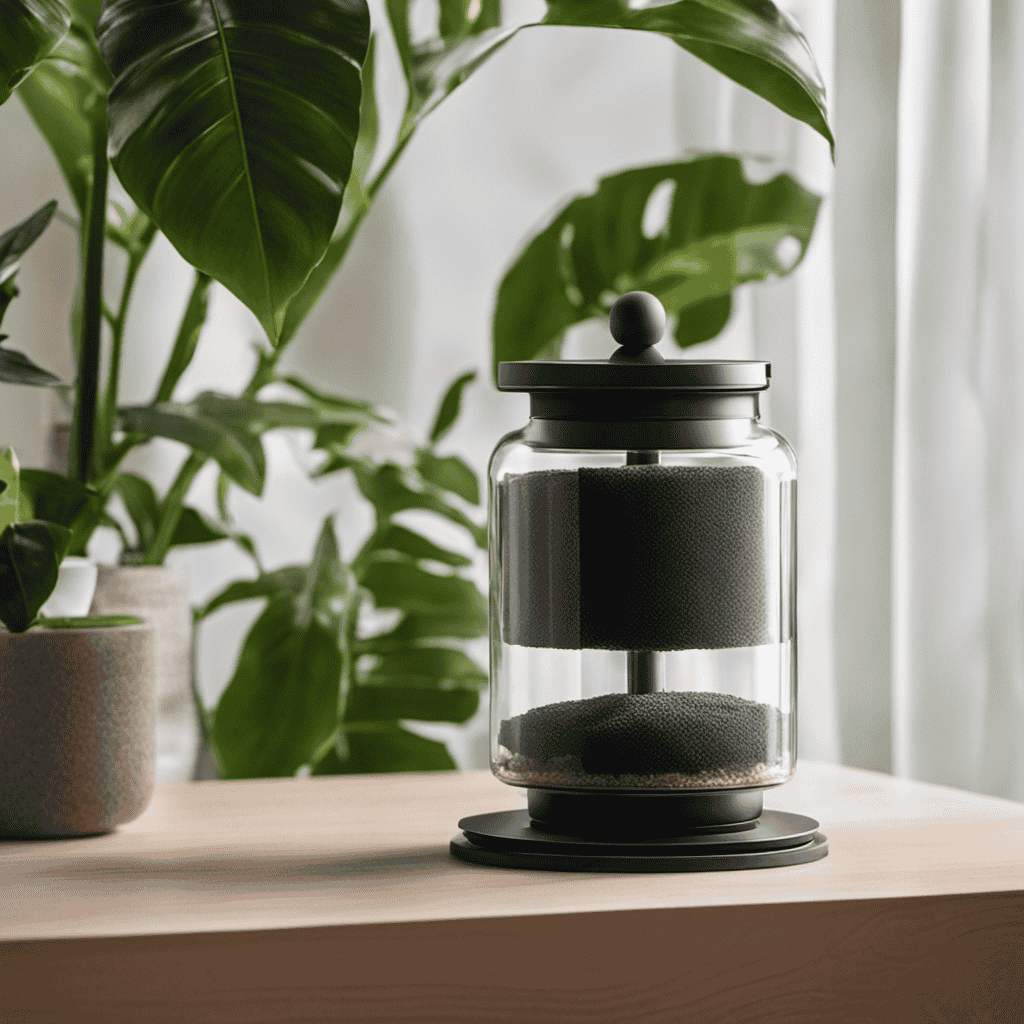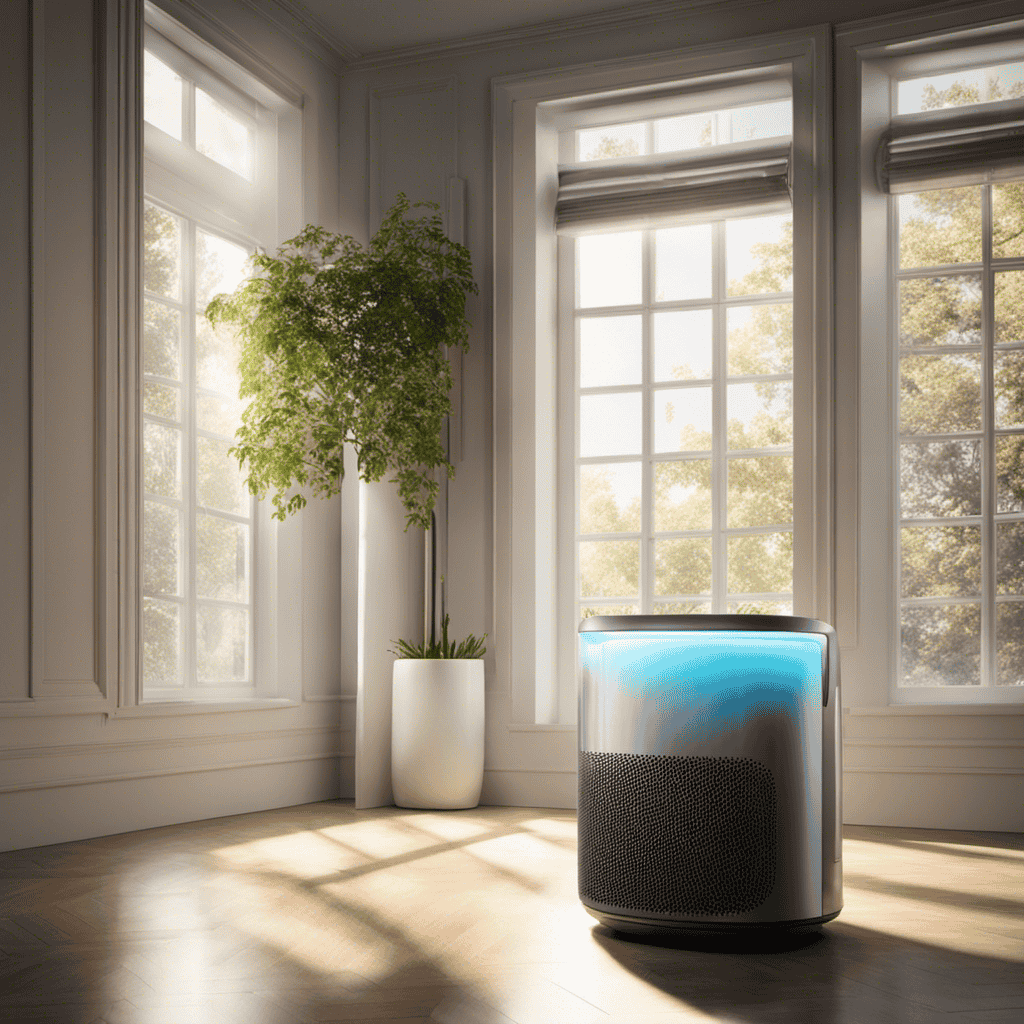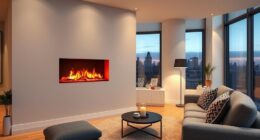I’ve always been concerned about the quality of the air in my home, especially with all the pollutants floating around. That’s why I decided to take matters into my own hands and create a homemade air purifier.
In this article, I’ll guide you through the process of building your own air purifier using easily accessible materials and tools. Trust me, it’s simpler than you think!
So let’s get started and breathe cleaner, fresher air in no time.
Key Takeaways
- Indoor air quality can be assessed using an air quality monitor to measure pollutants in the home.
- Common air pollutants include volatile organic compounds (VOCs), particulate matter, carbon monoxide, and formaldehyde.
- Selecting the right materials and tools, such as HEPA filters and a medium-sized fan, is important for building an effective homemade air purifier.
- Regular filter maintenance, including cleaning and replacement, is crucial for optimal air purification efficiency.
Assessing Indoor Air Quality
To assess your indoor air quality, you should use an air quality monitor to measure the levels of pollutants in your home. Assessing air pollution is crucial as poor air quality can have significant health effects.
Indoor air pollution can arise from various sources such as cooking, cleaning products, tobacco smoke, and building materials. These pollutants can lead to respiratory issues, allergies, and even long-term health problems. By using an air quality monitor, you can get an accurate reading of the levels of pollutants present in your home.
Air quality monitors typically measure various pollutants including particulate matter (PM), volatile organic compounds (VOCs), carbon dioxide (CO2), and humidity levels. PM refers to tiny particles suspended in the air, which can enter our respiratory system and cause harm. VOCs are released by many household products and can contribute to the development of respiratory symptoms and other health issues. Monitoring CO2 levels is essential as high concentrations can result in drowsiness, headaches, and poor concentration.
Understanding Common Air Pollutants
Understanding the most common air pollutants will help you identify potential sources of indoor pollution. Indoor pollutants can have significant health effects, so it is important to be aware of the types of pollutants that may be present in your home. Here are some of the most common indoor pollutants and their potential health effects:
| Indoor Pollutant | Health Effects |
|---|---|
| Volatile Organic Compounds (VOCs) | Eye, nose, and throat irritation, headaches, nausea, damage to liver, kidney, and central nervous system |
| Particulate Matter | Respiratory issues, such as coughing, wheezing, and shortness of breath, increased risk of heart disease and lung cancer |
| Carbon Monoxide | Headaches, dizziness, nausea, confusion, unconsciousness, death |
| Formaldehyde | Eye, nose, and throat irritation, respiratory issues, increased risk of cancer |
These pollutants can come from a variety of sources, including cleaning products, building materials, tobacco smoke, and gas appliances. It is important to take steps to reduce exposure to these pollutants, such as improving ventilation, using natural cleaning products, and regularly maintaining gas appliances. By understanding the most common indoor pollutants and their health effects, you can take proactive measures to create a healthier indoor environment for yourself and your family.
Selecting the Right Materials and Tools
When it comes to selecting the right materials and tools for making a homemade air purifier, there are two key points to consider.
Firstly, understanding the different filter types available and their effectiveness in capturing air pollutants is crucial in ensuring the efficiency of the air purifier.
Secondly, having the necessary tools and materials on hand is essential for successfully building and maintaining the homemade air purifier.
Filter Types and Effectiveness
If you’re looking for an effective filter for your homemade air purifier, consider using a HEPA filter. HEPA stands for High Efficiency Particulate Air, and these filters are designed to remove 99.97% of particles that are 0.3 microns or larger in size.
Here are some key points to keep in mind regarding filter types and effectiveness:
- HEPA filters are highly efficient in capturing allergens, dust, pet dander, and other fine particles.
- They are commonly used in professional-grade air purifiers due to their superior filtration capabilities.
- HEPA filters require regular maintenance, such as vacuuming or washing to remove accumulated debris.
Using a HEPA filter in your DIY air purifier ensures that the air in your home is clean and free from harmful pollutants. Remember to regularly clean and maintain your filter for optimal performance.
Essential Tools and Materials
To create your DIY air purifier, you’ll need a few essential tools and materials.
First, you’ll need a fan to circulate the air. A medium-sized fan should be sufficient for most rooms.
Next, you’ll need a high-efficiency particulate air (HEPA) filter. This type of filter is capable of removing airborne particles as small as 0.3 microns, including dust, pollen, and pet dander. You can find HEPA filters online or at your local hardware store.
Additionally, you’ll need a sturdy box or container to house the fan and filter. Make sure it’s large enough to accommodate both and has enough airflow.
Lastly, you’ll need some duct tape or zip ties to secure the fan and filter together.
Once you have these tools and materials, you can start assembling your homemade air filtration system.
Building the Air Purifier Frame
Once you’ve gathered all the necessary materials, you’ll need to start by constructing the air purifier frame. This is an essential step in building your homemade air purifier as it provides the structure and support for the entire system. Here are the steps to follow:
-
Measure and cut the plywood: Using a measuring tape, determine the dimensions for your frame. Cut the plywood accordingly, ensuring a snug fit for your air purifier components.
-
Assemble the frame: Lay the plywood pieces on a flat surface and align them to form a rectangular shape. Use wood screws or nails to secure the corners and reinforce the joints.
-
Reinforce the frame: To add stability, attach corner brackets at each corner of the frame. This will prevent any wobbling or shifting during operation.
-
Optional: Paint or seal the frame: If desired, you can paint or seal the frame to enhance its appearance and protect it from moisture or damage.
By following these steps, you will have successfully built the frame for your air purifier.
Remember to regularly maintain your air purifier by cleaning or replacing the filters, as well as implementing proper air filtration techniques, such as removing dust and ensuring proper airflow. This will ensure optimal performance and clean, fresh air in your space.
Installing the Air Filtration System
Installing the air filtration system is a crucial step in ensuring the effectiveness of your DIY purifier. Proper air purifier maintenance is essential to keep your system running smoothly and efficiently. In this section, I will guide you through the process of installing the air filtration system and provide some troubleshooting tips.
To begin, carefully remove the packaging from your air filters. Make sure to read the manufacturer’s instructions for any specific installation requirements.
Next, locate the air intake area on your homemade purifier. This is where the air will be drawn into the system for filtration. Attach the air filters securely to the intake area, ensuring a tight seal to prevent any air leakage.
Once the air filters are installed, it is important to regularly check and clean them. Over time, the filters can become clogged with dust and other particles, reducing their effectiveness. Gently vacuum or wash the filters according to the manufacturer’s instructions. This will help to maintain optimal airflow and filtration efficiency.
If you notice a decrease in air purifier performance or airflow, it may be a sign that the filters need to be replaced. Additionally, check for any signs of damage or wear on the filters, such as tears or holes. Damaged filters should be replaced immediately to ensure proper air filtration.
Enhancing Air Purification Efficiency
When it comes to improving indoor air quality, the type of filter used plays a crucial role in determining its effectiveness.
Different filters have varying levels of efficiency in removing pollutants from the air.
Understanding the different filter types and their effectiveness can help us make informed decisions on how to enhance air purification in our homes.
Filter Types for Effectiveness
To improve the effectiveness of your homemade air purifier, you should consider using HEPA filters. HEPA stands for High Efficiency Particulate Air, and these filters are designed to capture small particles and pollutants in the air.
Here are some reasons why HEPA filters are a great choice for your DIY air purifier:
- HEPA filters have a high efficiency rating, capturing 99.97% of particles as small as 0.3 microns.
- They are effective in removing common indoor air pollutants such as dust, pollen, pet dander, and mold spores.
- HEPA filters can help reduce symptoms of allergies and asthma by removing airborne irritants.
Using HEPA filters in your homemade air purifier ensures that the air you breathe is free from harmful pollutants. Regular air purifier maintenance, including replacing the filters, will help keep your air purifier working efficiently and effectively.
Improving Indoor Air Quality
Improving indoor air quality starts with using HEPA filters in your DIY air purifier. HEPA filters are highly effective at removing small particles from the air, such as dust, pollen, and pet dander. They can help reduce respiratory issues and allergies by providing cleaner air to breathe.
In addition to using HEPA filters, there are other natural air purification methods that can further enhance the benefits of your homemade air purifier. These methods include using plants that purify the air, such as snake plants and peace lilies, as well as utilizing essential oils with antimicrobial properties, like tea tree oil or eucalyptus oil.
By incorporating these natural methods alongside your HEPA filter, you can create a healthier and more comfortable living environment.
Now, let’s move on to maintaining and cleaning your homemade air purifier.
Maintaining and Cleaning Your Homemade Air Purifier
One way to keep your homemade air purifier running efficiently is by regularly cleaning the filters. This is an important maintenance tip to ensure that your air purifier continues to effectively remove pollutants from the air. Cleaning the filters not only improves the performance of the air purifier but also prolongs its lifespan.
Here are some cleaning techniques and maintenance tips to help you maintain your homemade air purifier:
-
Vacuum the filters: Use a vacuum cleaner with a brush attachment to remove dust and debris from the filters. This will help to improve the airflow and maintain the effectiveness of the air purifier.
-
Wash the filters: If your filters are washable, gently wash them with mild soap and water. Rinse thoroughly and allow them to air dry completely before reinstalling them. This will help to remove trapped particles and ensure the filters are clean and functioning properly.
-
Replace the filters: If your filters are not washable, it is important to replace them regularly according to the manufacturer’s instructions. This will ensure that your air purifier is always working at its best.
Regularly cleaning and maintaining your homemade air purifier will help to ensure its efficiency and effectiveness in improving the air quality in your home.
Frequently Asked Questions
Can a Homemade Air Purifier Completely Eliminate All Indoor Air Pollutants?
A homemade air purifier has its limitations when it comes to completely eliminating all indoor air pollutants. While it can improve indoor air quality to some extent, it may not be as effective as commercial air purifiers.
However, there are still benefits to using homemade air purifiers, such as reducing dust, pet dander, and other common allergens. It’s important to remember that the effectiveness of any air purifier depends on factors like room size and the type of pollutants present.
How Often Should I Replace the Air Filters in My Homemade Air Purifier?
When it comes to the replacement frequency of air filters in a homemade air purifier, it is important to consider a few factors.
These include the quality of the air filters used, the level of pollutants in the environment, and the frequency of use.
Generally, air filters should be replaced every 3 to 6 months. However, it is advisable to check the manufacturer’s instructions for specific guidelines.
It is also worth noting that homemade air purifiers can be a cost-effective alternative to commercial ones, as replacement filters are often cheaper.
Can I Use Essential Oils in My Homemade Air Purifier to Freshen the Air?
Using essential oils in a homemade air purifier can be a great way to freshen the air. However, it’s important to use them safely. Essential oils should be diluted before being added to the air purifier to prevent any irritation or allergies.
Additionally, it’s worth exploring alternatives to essential oils for air freshening, such as natural odor absorbers like baking soda or activated charcoal. These options can be just as effective in keeping the air smelling clean and fresh.
Are There Any Specific Safety Precautions I Should Take When Building and Using a Homemade Air Purifier?
When building and using a homemade air purifier, it’s important to take specific safety precautions.
First, ensure that all electrical components are properly installed and grounded to prevent electrical hazards.
Additionally, consider using a high-efficiency particulate air (HEPA) filter to effectively remove airborne particles.
It’s crucial to regularly clean and maintain the filter to avoid the accumulation of allergens and pollutants.
Lastly, keep the purifier away from flammable materials and ensure proper ventilation to prevent any potential fire hazards.
Can a Homemade Air Purifier Help Reduce Allergies and Asthma Symptoms?
A homemade air purifier can indeed help reduce allergies and asthma symptoms. Studies have shown that indoor air can be up to 5 times more polluted than outdoor air, making it a prime trigger for respiratory issues.
Can I Use My AC as an Air Purifier Using Homemade Methods?
Yes, you can improve indoor air quality using AC as air purifier. Simple homemade methods like placing charcoal or baking soda near the intake vent, or using essential oil diffusers can help in trapping and eliminating airborne pollutants. Regularly changing the air filter and keeping the AC well-maintained also enhances its air purifying capabilities.
Conclusion
After assessing the indoor air quality and understanding the common pollutants, I embarked on a journey to create my own homemade air purifier.
Armed with the right materials and tools, I built a sturdy frame and installed a powerful air filtration system.
The results were astounding! The air in my home now feels like a cool breeze on a hot summer day, refreshing and pure.
Maintaining and cleaning my homemade air purifier is a breeze too, ensuring its efficiency never wavers.
Take control of your air quality and experience the transformative power of a homemade air purifier.










